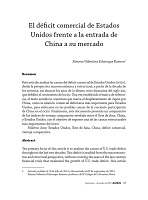El déficit comercial de Estados Unidos frente a la entrada de China a su mercado
DOI:
https://doi.org/10.32870/mycp.v1i2.392Palabras clave:
Estados Unidos, Este de Asia, China, déficit comercial, ventaja comparativa.Resumen
Este artículo analiza las causas del déficit comercial de Estados Unidos (dceu), desde la perspectiva macroeconómica y estructural, a partir de la década de los noventa, sin abarcar los años de la última crisis financiera del siglo xxi, que debilitó el crecimiento del dceu. Una vez establecido el marco de referencia, el texto estudia la coyuntura que marca el desplazamiento de Japón por China, como la relación comercial deficitaria más importante para Estados Unidos, para enfocarse en las posibles causas de la creciente participación de China en el dceu. Finalmente, este documento presenta un comparativo de los índices de ventaja comparativa revelada entre el Este de Asia, China, y Estados Unidos, con el objetivo de exponer una de las causas estructurales más importantes del dceu. Abstrac: The primary focus of this article is to analyze the causes of U.S. trade deficit throughout the last two decades. This deficit is studied from the macroeconomic and structural perspective, without covering the years of the last century financial crisis that weakened the growth of U.S. trade deficit. This article exhibits the shift from Japan to China as the most imbalanced bilateral trade relationship for the United States, focusing on the possible causes of China’s increasing participation in U.S. trade deficit. These facts are classified into exogenous and endogenous in order to establish the uniqueness of China’s presence in the U.S. market. Finally, this paper presents a comparison of revealed comparative advantage indices among the major economies of East Asia, China and the United States to expose the regional dynamics that helps China to remain a leading exporter.Descargas
Citas
Arrighi, Giovanni (2010), The Long Twentieth Century. Money and Origins of our Times, Londres, Verso. pp. 336-370.
Athukorala, Prema-Chandra (2010), “China and Southeast Asia in the New Regional Division of Labour”, en Yueh, Linda (ed.), The Future of Asian Trade and Growth. Economic Development with the Emergence of China, Londres, Routledge, pp. 406-432.
Blecker, Robert, A. (1996), U.S. Trade Policy and Global Growth, Washington, DC, Economic Policy Institute.
Bradsher, Keith (2008), ”Investors Seek Asian Options to Costly China”, The New York Times, Negocios Mundiales, 18 de junio, p. A1.
Elwell, Craig K. (2004), ”Deindustrialization of the U.S. Economy: The Roles of Trade, Productivity, and Recession”, crs Report for Congress, RL32350.
Griswold, Daniel T. (2001), “America’s Record Trade Deficit. A Symbol of Economic Strength”, Trade Policy Analysis, 12, pp. 1-19.
International Monetary Fund (2006), “Global Financial System Resilience in the face of Cyclical Challenges”, Global Financial Stability Report, 1, p. 35.
Krugman, Paul (2009), The Return of Depression Economics and the Crises of 2008, New York, W.W. Norton & Company, pp. 56-76, 139-152.

Publicado
Cómo citar
Número
Sección
Licencia
Política de acceso abierto
Esta revista proporciona un acceso abierto a su contenido, fiel al principio de que ofrecer al público un acceso libre a las investigaciones ayuda a un mayor intercambio global del conocimiento.
MyCP se publica bajo la licencia de Creative Commons Reconocimiento-No Comercial CC BY-NC
Los contenidos serán publicados en versión PDF y XML.
Los autores(as) que publiquen en México y la Cuenca del Pacífico aceptan las siguientes condiciones:
De acuerdo con la legislación de derechos de autor, México y la Cuenca del Pacífico reconoce y respeta el derecho moral de los autores(as), así como la titularidad del derecho patrimonial, mismo que será cedido a la Universidad de Guadalajara para su difusión en acceso abierto.
México y la Cuenca del Pacífico no realiza cargos a los autores(as) por enviar y procesar artículos para su publicación.
Los autores(as) pueden realizar otros acuerdos contractuales independientes y adicionales para la distribución no exclusiva de la versión del artículo publicado en México y la Cuenca del Pacífico (por ejemplo, incluirlo en un repositorio institucional o darlo a conocer en otros medios en papel o electrónicos) siempre que indique clara y explícitamente que el trabajo se publicó por primera vez en México y la Cuenca del Pacífico.
Una vez que se acepte el artículo para su publicación los autores(as) deben remitir el formato de carta-cesión de derechos de la publicación debidamente requisitado y firmado por los autores(as). Este formato debe ser remitido en archivo PDF paralelamente con la versión final del artículo al correo: mexicoylacuenca@gmail.com.
Los lectores/usuarios de México y la Cuenca del Pacífico pueden acceder directamente al contenido de manera libre y gratuita en todo momento, incluyendo cuando un nuevo número es colocado en la plataforma. Se permite al lector/usuario citar, compartir (electrónicamente y de manera física), imprimir y distribuir el material siempre que se indique de manera clara y explícitamente que el trabajo se publicó por primera vez en México y la Cuenca del Pacífico. Es necesario citar de manera correcta el trabajo y no debe de ser utilizado con fines comerciales.




